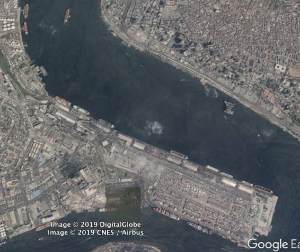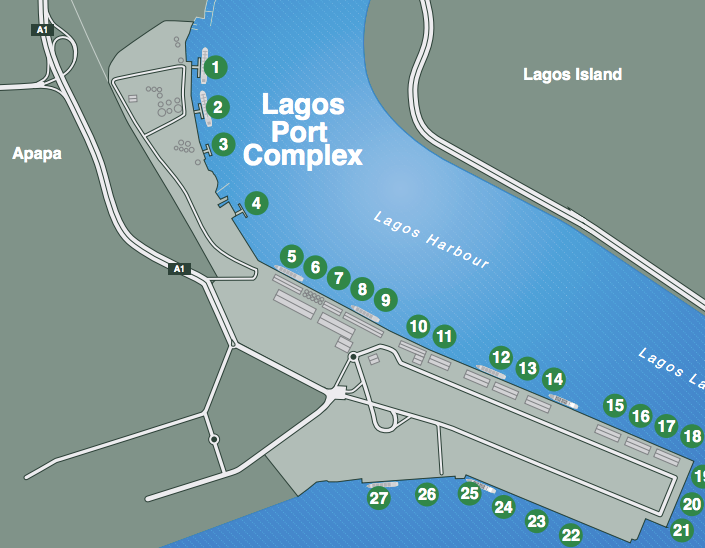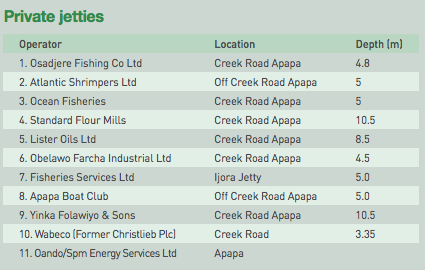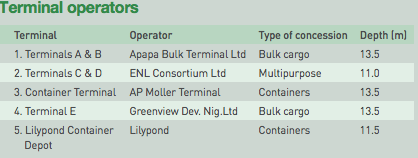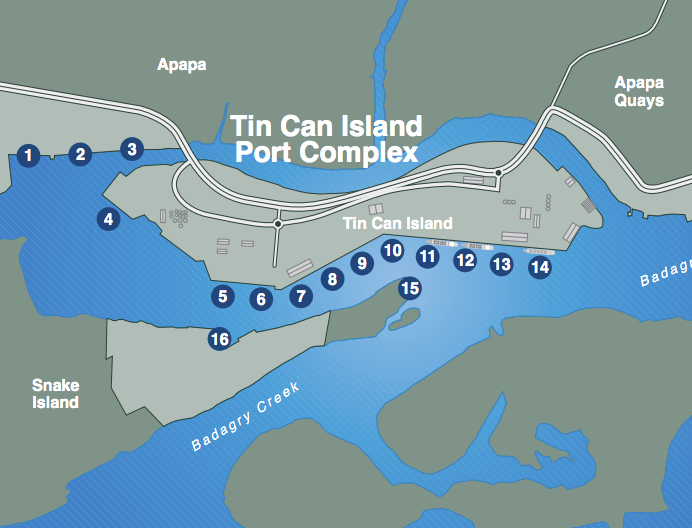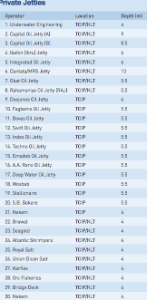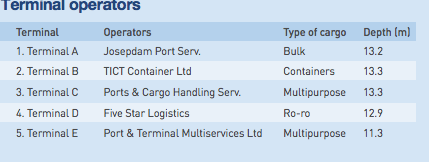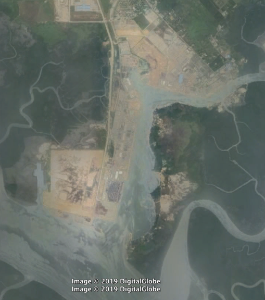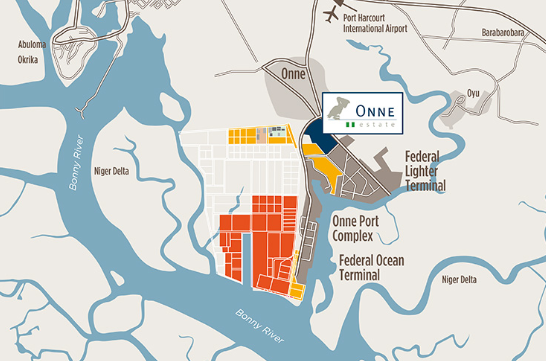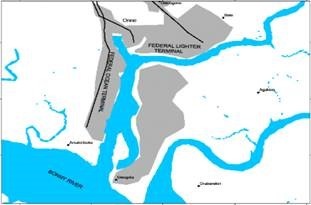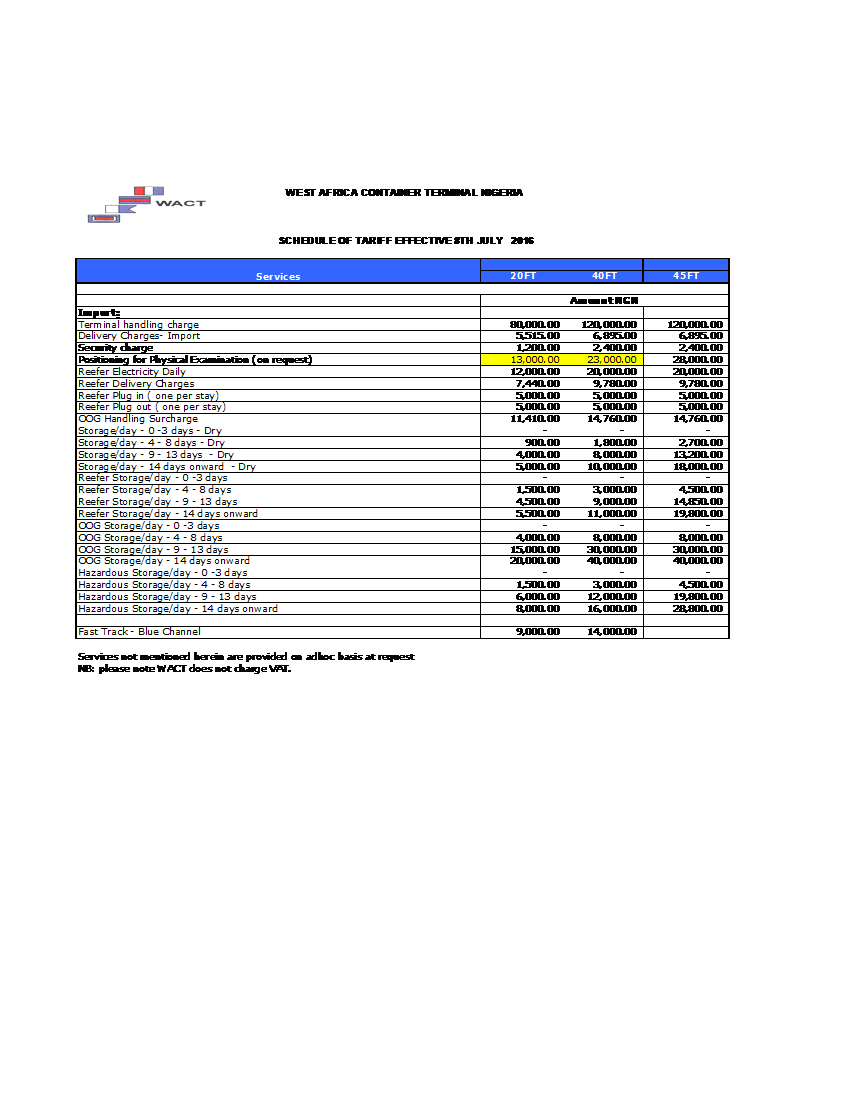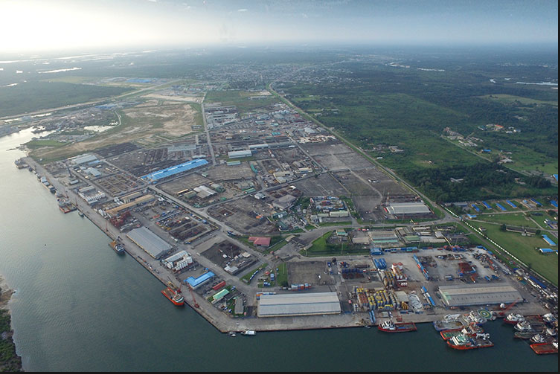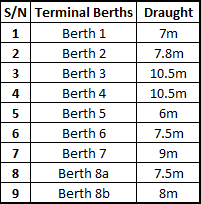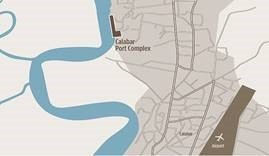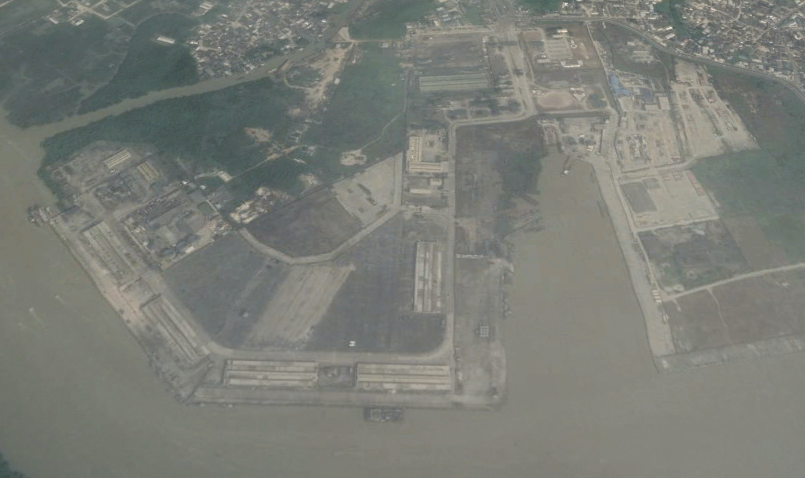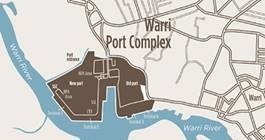2.1 Nigeria Port Assessment
The Nigerian Ports Authority (NPA) is a federal government agency that governs and operates the ports of Nigeria. Since the year 2000 the NPA, on behalf of the government, has led a process of port privatization and management concessions. This has resulted in improved management, increased capital expenditure on handing equipment, technologies and facilities with a resultant improvement in overall productivity and efficiency.
Nigeria has six major ports controlled by the Nigeria Ports Authority (NPA), they include: the Lagos Port Complex and Tin Can Island Port in Lagos; Calabar Port, Delta Port (Warri), Rivers Port at Port Harcourt, and Onne Port.
The ports of Warri, Onne, Port Harcourt and Calabar are multi-purpose facilities located in one the world’s largest crude oil production regions, the Niger delta, and their emphasis is on support of this sector. As they continue to invest in infrastructure, expanding their services and levels of operation, there is potential to further utilize these ports to alleviate the congestion at the Lagos port complex.
Lagos is the main point of entry for Nigeria’s import and export commodity trade.
The Lagos Port complex is severely hampered by bottlenecks caused by traffic gridlock due to on-going access road rehab works and due to the large numbers of trucks entering and exiting the port facilities.
Multiple checkpoints in front of the port and environs further add to delays and the congestion issues.
2.1.1 Nigeria Port of Apapa Quays (Lagos)
Port Overview
The Lagos Port Complex also referred to as Premiere Port (Apapa Quays) is the earliest and largest Port in Nigeria. It is situated in Apapa, Lagos State, the commercial centre of Nigeria.
The Lagos Port Complex has five (5) private Terminals and eight (8) jetties. The Terminal Operators are:
- AP Moller Terminal Ltd. (APMT),
- ENL Consortium Ltd. (ENL),
- Apapa Bulk Terminal Ltd. (ABTL),
- Greenview Development Nigeria Ltd. (GNDL)
- Lilypond Inland Container Terminal.
The Port has two (2) Logistics bases:
- Eko Support Services Ltd. and
- Lagos Deep Offshore Logistics (LADOL).
It is registered as an ISPS certified Port facility and offers 24hrs operation. All operational areas are guarded by both armed and unarmed security personnel, as well as with Closed Circuit Television (CCTV).
The Apapa Port is well equipped with modern cargo handling equipment and personnel support facilities. It has intermodal connection – rail (to 1 terminal), water and road, however road transport is by far the dominant method. This results in bottlenecks caused by traffic gridlock due to the large numbers of trucks entering and exiting the port facilities and parked on access roads waiting call up.
Military and paramilitary checkpoints close to the ports and environs further add to delays and the congestion issues.
The Terminal has the added advantage of APM Terminals’ Lilypond Inland Container Depot (ICD) located just 4 km from the port. Covering an area of 120,000 m2 it provides an additional capacity of 7,000 TEUs.
Sugar, salt and flour are produced in factories belonging to operators within the port.
Port website: www.nigerianports.gov.ng/lagos-port/
Key port information may also be found at: http://www.maritime-database.com
|
Port Location and Contact |
|
|
Country |
Nigeria |
|
Province or District |
Lagos State |
|
Nearest Town or City with Distance from Port |
Lagos - 1 km |
|
Port's Complete Name |
Lagos Port Complex |
|
Latitude |
06°25’7” N |
|
Longitude |
003°20’53” E |
|
Managing Company or Port Authority |
Nigeria Ports Authority (oversight) Terminals A & B: Apapa Bulk Terminal Ltd Terminals C & D: ENL Consortium Ltd. Container Terminal: AP Moller. Terminal E: Greenview Dev. Nig.Ltd. Lilypond Container Terminal: Lilypond |
|
Management Contact Person |
Nigeria Ports Authority |
|
Nearest Airport and Airlines with Frequent International Arrivals/Departures |
Lagos Murtala Muhammed International Airport Arik Air, British Airways, Delta Airlines, Emirates, Ethiopian Airlines, Etihad Airways, KLM, Lufthansa, Qatar Airways, Virgin Atlantic Airways |
Port Picture
Description and Contacts of Key Companies
Under the NPA concession scheme the following operators are responsible for the management, maintenance and operations of one each of the eight terminals.
The Terminal Operators are: AP Moller Terminal Ltd. (APMT), ENL Consortium Ltd. (ENL), Apapa Bulk Terminal Ltd. (ABTL), Greenview Development Nigeria Ltd. (GNDL) and Lilypond Inland Container Terminal.
For more information on port contacts, please see the following link: 4.4 Nigeria Port and Waterways Company Contact List
Port Performance
Max. size: Anchorage: LOA 182.9 m., draft 8.53 m. Containers: Draft 12.0 m. Bulk: Draft 12.5 m. Tankers: LOA 190 m., draft 13.0 m. Gas: Draft 11.0 m.
Port is congested due to slower than optimum turnaround times. Additionally there is congestion occurring as a result of road transport bottlenecks. There is no priority for humanitarian cargoes.
|
Seasonal Constraints |
||
|
Occurs |
Time Frame |
|
|
Rainy Season |
Yes |
From April to September |
|
Major Import Campaigns |
Yes |
From October to March |
|
Other Comments |
The peak months of the rainy season is between the months of July and August. The major import periods precede the end of year festivities for Nigeria and its major trading partners (Chinese New Year) |
|
|
Handling Figures for 2017 |
|
|
Vessel Calls |
1,154 |
|
Container Traffic (TEUs) |
361,247 |
|
Handling Figures Bulk and Break Bulk for 2017 |
|
|
Bulk (MT) |
19,099,690 MT |
|
Break bulk (MT) |
25,000,000 MT |
Discharge Rates and Terminal Handling Charges
For information on port rates and charges, please see the following link: http://nigerianports.gov.ng/port-tariffs/
Additionally, individual terminal operators levy tariff charges these rates can be viewed at the following links:
http://port.enlconsortium.com/reports/Tariff%20Book.pdf
https://www.apmterminals.com/en/apapa
https://www.greenviewterminal.com/terminal_details.php
http://sifaxgroup.com/wp-content/uploads/2017/06/PCHS-Company-Service-Tariff.pdf
Berthing Specifications
|
Type of Berth |
Total Quantity |
Length (m) |
Maximum Draft (m) |
Comments (Operator) |
|
Conventional Berth |
100+ |
Ranging 146 – 157m |
Ranging 10.5 to 13.5 |
Apapa bulk Terminal Ltd |
|
Container & General |
130+ |
122 – 220m |
10 |
ENL Consortium |
|
75+ |
150m – 180m |
12.5 |
||
|
Container Berth |
20 |
140m - 180m |
12.5 |
APMT |
|
Silo Berth |
30 |
50m |
|
|
|
Berthing Tugs |
100+ |
50m |
|
|
|
Water Barges |
50 |
40m |
|
|
Clearing and forwarding agents will allocate
appropriate berths for the necessary cargo requirement.
General Cargo Handling Berths
|
Cargo Type |
Berth Identification |
|
Imports - Bagged Cargo |
Apapa 1 -14,19 -20 |
|
Exports - Bagged Cargo |
|
|
Imports and Exports - RoRo |
No RoRo |
|
Other Imports |
Port Handling Equipment
Port equipment is managed by the terminal operators.
|
Equipment |
Available |
Total Quantity and Capacity Available |
Comments on Current Condition and Actual Usage |
|
Dockside Crane |
Yes |
Multi-purpose x 5+ Portainer x 2 (35MT)+ Floating (250MT)+ Quay (5MT)+ |
Functional - good |
|
Container Gantries |
Yes |
Sufficient for demand |
Functional - good |
|
Mobile Cranes |
Yes |
Sufficient for demand |
Functional - good |
|
Reachstacker |
Yes |
Sufficient for demand |
Functional - good |
|
RoRo Tugmaster (with Trailer) |
Yes |
Sufficient for demand |
Functional - good |
|
Grain Elevator with Bagging Machines |
Yes |
Sufficient for demand |
Functional - good |
|
Transtainer |
Yes |
Sufficient for demand |
Functional - good |
|
Forklifts |
Yes |
Sufficient for demand |
Functional - good |
|
Conveyors |
Yes |
Sufficient for demand |
Functional - good |
Container Facilities
There are extensive container facilities. Apapa is one of the busiest container ports in Africa
|
Facilities |
20 ft |
40 ft |
|
Container Facilities Available |
Yes |
|
|
Container Freight Station (CFS) |
Yes |
|
|
Refrigerated Container Stations |
Yes |
|
|
Other Capacity Details |
Port is congested but there are sufficient Inland Container Depot facilities available. |
|
|
Daily Take Off Capacity |
There are no delays as a result of offloading capacity. Container unloading facilities are efficient. |
|
|
Number of Reefer Stations |
1000+ |
|
|
Emergency Take-off Capacity |
There are no delays as a result of offloading capacity. Container unloading facilities are efficient. |
|
|
Off take Capacity of Gang Shift |
There are no delays as a result of offloading capacity. Container unloading facilities are efficient. |
|
Customs Guidance
The Nigerian customs has functions which includes but is not limited to the following: Collection of revenue (Import /Excise Duties & other Taxes /Levies) and accounting for same; anti-smuggling activities; security functions; generating statistics for planning and budgetary purposes; monitoring Foreign Exchange utilisation, etc; engaging in Research, Planning and Enforcement of Fiscal Policies of Government; manifest processing; licensing and registration of Customs Agents; registration and designation of collecting banks; and working in collaboration with other government agencies in all approved ports and border station. Customs offices are located within and outside the port complex.
There are 3 units: inspection, clearing and gate control.
Hours are weekdays between 1000 to 1600 for clearing and 1000-2000 hours for release. Clearing and release officers do not operate weekends or public holidays and may be more difficult to engage on Fridays. Customs Gate Exit officers are on duty 24/7.
For more information on customs in Nigeria please see the following link: 1.3 Nigeria Customs Information
Terminal Information
MULTIPURPOSE TERMINAL
There are multiple multipurpose terminals available they have all necessary facilities (handling equipment, space, storage etc) available.
GRAIN AND BULK HANDLING
There are bulk handling and bagging facilities available in the port. They are not available on all terminals. Clearing and forwarding agents will advise which terminal should be used if these facilities are required. Direct bagging from ship discharge is not possible but can be facilitated in the port area.
MAIN STORAGE TERMINAL
There is sufficient current warehouse space for food stores, bagged and general cargo however not all facilities are totally secure. This should be checked with clearing agents.
|
Storage Type |
Number of Storage Facilities |
Area (m2) |
|
Bagged Cargo |
Sufficient for current demand and surge |
|
|
Refrigerated Cargo |
Refrigerated containers only |
1000+ connections |
|
General Cargo |
Sufficient for current demand and surge |
|
Stevedoring
Stevedoring services are the sole responsibility of the terminal operators. In addition to in-house stevedores, there are several third-party service providers registered with each terminal and the terminal operators nominate stevedoring companies to handle respective vessels. Stevedoring services are adequate and skilled.
Hinterland Information
More than 90 percent of all import shipments are moved out from the port by road. Goods or containers are loaded on respective trucks for delivery to destination. Truck ownership here is a combination of terminal and third-party vendors. Only a small percentage of cargo is initially moved using barges which haul these shipments to another location within the port city from where they are also eventually loaded onto waiting trucks. ATM Terminal has the only access to rail. They load less than 20 percent of their total cargo out by this method.
Port Security
All terminal facilities here currently operate on ISPS level 1. There are strict access control mechanisms put in place by each terminal to prevent the entry of un-authorized personnel into the terminal. All authorized persons must conform to international safety standards.
|
Security |
|
|
ISPS Compliant |
Yes |
|
Current ISPS Level |
Level 1 |
|
Police Boats |
Yes |
|
Fire Engines |
Yes |
2.1.2 Nigeria Port of Tin Can Island
Port Overview
Tin Can Island Port is the second busiest Port in Nigeria after Apapa Port. The port handles diversified cargoes with each terminal operator specializing in different forms of cargo (Dry and Wet bulk cargoes, Box-Containerized cargoes, RORO services). The port handles vessels ranging from 100m – 260m. It is well-equipped and up to date with modern equipment for clearing cargoes.
It provides water supply and bunkering and 24 hours pilotage service.
Private terminal operators operate all terminals and average berth occupancy rate is 83% as at 2018.
The facilities can handle ships of about 30,000 tonnes.
Tin Can Port is well equipped with modern cargo handling equipment and personnel support facilities. It has intermodal connection – water and road, however road transport is by far the dominant method. This results in bottlenecks caused by traffic gridlock due to the large numbers of trucks entering and exiting the port facilities and parked on access roads waiting call up.
Military and paramilitary checkpoints are present in front of the ports and environs.
Port website: http://nigerianports.gov.ng/tincan/
- Josepdam Terminal: http://www.jps.ng/
- Ports & Cargo Terminal: http://sifaxgroup.com/company/ports-and-cargo/
- Five Star Terminal: http://www.fivestarlogisticsltd.com/
- Ports and Terminal Multiservice Ltd: http://www.ptml-nigeria.com/index.html
Key port information may also be found at: https://www.maritime-database.com/
|
Port Location and Contact |
|
|
Country |
Nigeria |
|
Province or District |
Lagos |
|
Nearest Town or City with Distance from Port |
Lagos 7 Km |
|
Port's Complete Name |
Tin Can Island Port |
|
Latitude |
06°25.7’N |
|
Longitude |
003°20.53E |
|
Managing Company or Port Authority
|
Terminal A Josepdam Port Serv. www.jps.ng Terminal B TICT Container Ltd www.tict-ng.com Terminal C Ports & Cargo Handling Serv. www.sifaxgroup.com Terminal D Five Star Logistics www.fivestarlogisticsltd.com Terminal E Port & Terminal Ltd www.ptml-nigeria.com |
|
Management Contact Person |
Terminal A: Josepdam Port Serv. Mr. Sunday Aindero / 08037241211 / saindero@jps.ng
Terminal B: TICT Container Ltd Yann Magarian
Terminal C: Ports & Cargo Handling Serv. Mr. John Jenkins/08102852900/ johnje@sifaxgroup.com
Terminal D: Five Star Logistics Mr. Wolfgang Schneider / 08090401287 / wolfgang.schneider@5starterminal.com
Terminal E: Ports and Terminals Multiservices Ltd. www.ptml-nigeria.com |
|
Nearest Airport and Airlines with Frequent International Arrivals/Departures |
Lagos Murtala Muhammed International Airport Arik Air, ASKY, British Airways, Delta Airlines, Egypt Air, Emirates, Ethiopian Airlines, Etihad Airways, KLM, Lufthansa, Middle East Airways, Qatar Airways, Virgin Atlantic Airways |
Port Picture
Description and Contacts of Key Companies
Under the NPA concession scheme the following operators are responsible for the management, maintenance and operations of one each of the 5 terminals.
Terminal services offered are bulk, containers, multipurpose and Ro-ro
The terminal operators are:
- Josepdam Port Services,
- TICT Container Ltd,
- Ports & Cargo Handling Services,
- Five Star Logistics,
- Port & Terminal Multiservice Ltd
For more information on port contacts, please see the following link: 4.4 Nigeria Port and Waterways Company Contact List
Port Performance
Tin Can Island has 5 terminals with varying areas of specialty.
- Terminal A is predominantly a breakbulk terminal,
- Terminal B a core container terminal,
- Terminal C, D & E are conventional terminals (containerized, break bulk & RORO).
The draft of the Tin Can channel is 15 metres while draft alongside the terminals range 12.5 - 13 metres and may be unsuitable for ocean going vessels requiring more drafts.
Terminal berths are fully optimized however port is congested due to slower than optimum turnaround times. Major bottleneck also occurs as a result of the truck congestion to and from the port complexes. This is now being addressed using holding bays and progress/impact is being monitored. Average waiting time at Tin Can is 2.5 days.
Cumulative cargo handling capacity of Tin Can (incl. container volume) in 2017 was 15,520,925 MT.
|
Seasonal Constraints |
||
|
|
Occurs |
Time Frame |
|
Rainy Season |
Yes |
From April to September |
|
Major Import Campaigns |
Yes |
From October to March |
|
Other Comments |
The peak months of the rainy season is between the months of July & August. The major import periods precede the end of year festivities for Nigeria and its major trading partners (Chinese New Year) |
|
|
Handling Figures for 2017 |
|
|
Vessel Calls |
1,350 vessels |
|
Container Traffic (TEUs) |
862,273 |
|
Handling Figures Bulk and Break Bulk for 2017 |
|
|
Bulk (MT) |
15,521,000 |
|
Break bulk (MT) |
27,000,000 |
Discharge Rates and Terminal Handling Charges
For information on port rates and charges, please see the following links to the websites of the terminal management companies:
Josepdam Port services: https://www.jps.ng/
Ports & Cargo: http://sifaxgroup.com/companies/ports-and-cargo-handling-services-limited/
PTML: https://billing.grimaldi-nigeria.com/
TICT: https://www.tict-ng.com/
Five Star Logistic: http://www.fivestarlogisticsltd.com/
Berthing Specifications
|
Type of Berth |
Quantity |
Length (m) |
Maximum Draft (m) |
Comments |
|
Conventional Berth |
50+ |
N/A |
12.5m |
There is no specific LOA allocated for conventional berths |
|
Container Berth |
100+ |
2072m |
12.5m |
- |
|
General Berth |
50 |
|
|
|
|
RoRo Berth |
1 |
485 |
|
|
|
Silo Berth |
20 |
484m |
12.5m |
Silos are privately owned but available for 3rd party lease |
|
Berthing Tugs |
20+ |
50m |
- |
Tug boats are allocated to vessels by the Nigeria Port Authorities |
|
Water Barges |
60+ |
40m |
- |
Container barges are privately owned and operated. RORO barge available is owned and operated by PTML terminal |
The total LOA for all terminals in
Tin Can is 2,980m and with an average
draft of 12.5 meter.
General Cargo Handling Berths
|
Cargo Type |
Berth Identification |
|
Imports - Bagged Cargo |
1, 1A, 2 & 12 (Joseph dam & Five star) |
|
Exports - Bagged Cargo |
1, 1A, 2 & 12 (Joseph dam & Five star) |
|
Imports and Exports - RoRo |
8,9 & 12 (Grimaldi / PTML) |
|
Other Imports |
Steel coils, Hardboards, paper reels etc |
Port Handling Equipment
The respective terminals are all concessional leases by the government to private businesses who now operate and manage the port facilities and in turn pay royalties to the government for the period of concession.
|
Equipment |
Available |
Total Quantity and Capacity Available |
Comments on Current Condition and Actual Usage |
|
Dockside Crane |
Yes |
Sufficient for demand |
Terminal B & C are both fitted with RTG gantry and mobile cranes respectively. |
|
Container Gantries |
Yes |
Sufficient for demand |
Available in Terminal B & C |
|
Mobile Cranes |
Yes |
Sufficient for demand |
Available in Terminal B, C, D & E |
|
Reachstacker |
Yes |
Sufficient for demand |
Available at all terminals |
|
RoRo Tugmaster (with Trailer) |
Yes |
Sufficient for demand |
Available at select terminals |
|
Grain Elevator with Bagging Machines |
Yes |
Sufficient for demand |
Available upon request and for a fee as this is not terminal owned |
|
Transtainer |
Yes |
Sufficient for demand |
Available at select terminals |
|
Forklifts |
Yes |
Sufficient for demand |
Available at all terminals |
Container Facilities
|
Facilities |
20 ft |
40 ft |
|
Container Facilities Available |
Forklifts, Reach stackers, Mobile cranes, RTG Gantry cranes |
|
|
Container Freight Station (CFS) |
Yes |
Yes |
|
Refrigerated Container Stations |
Yes |
Yes |
|
Number of Reefer Stations
|
500+ |
|
|
Other Capacity Details |
Upon periods of terminal congestion, units are transferred to off-dock locations for pick up. |
|
|
Daily Take Off Capacity
|
There are no delays as a result of offloading capacity. Container unloading facilities are efficient. |
|
|
Number of Reefer Stations
|
Terminal A: Nil Terminal B: 200 Terminal C: 102 Terminal D: TBC Terminal E: TBC
|
Terminal A: Nil Terminal B: 200 Terminal C: 102 Terminal D: TBC Terminal E: TBC |
|
Emergency Take-off Capacity |
There are no delays as a result of offloading capacity. Container unloading facilities are efficient. |
|
|
Off take Capacity of Gang
Shift
|
There are no delays as a result of offloading capacity. Container unloading facilities are efficient.
|
|
Customs Guidance
The Nigerian customs has functions which includes but is not limited to the following: Collection of revenue (Import /Excise Duties & other Taxes /Levies) and accounting for same; anti-smuggling activities; security functions; generating statistics for planning and Budgetary purposes; monitoring Foreign Exchange utilisation, etc; engaging in Research, Planning and Enforcement of Fiscal Policies of Government; manifest processing; licensing and registration of Customs Agents; registration and designation of collecting banks; and working in collaboration with other government agencies in all approved ports and border station. Customs offices are located within and outside the port complex.
There are 3 units; inspection, clearing and gate control.
Hours are weekdays between 1000 to 1600 for clearing and 1000-2000 hours for release. Clearing and release officers do not operate weekends or public holidays and may be more difficult to engage on Fridays. Customs Gate Exit officers are on duty 24/7
For more information on customs in Nigeria, please see the following link: 1.3 Nigeria Customs Information
Terminal Information
Multipurpose terminal
There are multiple multipurpose terminals available they have all necessary facilities (handling equipment, space, storage etc) available.
Terminal D & E are multipurpose terminals which caters to both containerized and general cargo vessels.
Terminal D has 1 dedicated berth to RORO vessels with terminal capacity to hold 5000 vehicles at a time. Warehouse facility available is 6,300 m2.
Terminal E has 2 berths available for RORO or container vessels. Vehicle holding area of terminal is 230,000 m2 and this is including holding facility outside the port complex but is fed using barges. Warehouse facility available is 3,500 m2.
Grain and bulk handling
Only the Josepdam terminal (Terminal A) is fitted with suckers for handling grain and bulk shipment. These suckers take up grains from vessels alongside and into Silos. The storage capacity of the silos is 28,000 MT of grain. Suckers are owned but owned by a private business using same for its products/vessels. These suckers are available for lease if required.
The terminal handles wheat, maize and malt and can take delivery of about 4000 MT of grain daily. The facilities can handle ships of about 30,000 tonnes. There is also a grain bagging facility on-site which is transported by Fleetwood Transportation.
Main storage terminal
There is sufficient current warehouse space for food stores, bagged and general cargo however not all facilities are totally secure. This should be checked with clearing agents.
Terminal A, D & E all have 1 warehouse facilities each within the terminal. However only Terminal A allows cargo storage in the open stack area.
|
Storage Type |
Number of Storage Facilities |
Area (m2) |
|
Bagged Cargo |
3 terminal warehouse facilities |
18,574 |
|
Refrigerated Cargo |
4 Terminals facilities |
N/A |
|
General Cargo |
1 Terminal open stacking area |
17,000 |
Stevedoring
Stevedoring services are the sole responsibility of the terminal operators. In addition to in-house stevedores, there are several third-party service providers registered with each terminal and the terminal operators nominate stevedoring companies to handle respective vessels. Stevedoring services are adequate and skilled.
Hinterland Information
More than 90% of all import shipments are moved out from the port by road. Goods or containers are loaded on respective trucks for delivery to destination. Truck ownership here is a combination of terminal and third-party vendors. Only a small percentage of cargo is initially moved using barges which haul these shipments to another location within the port city from where they are also eventually loaded onto waiting trucks.
Port Security
All terminal facilities here currently operate on ISPS level 1. There are strict access control mechanisms put in place by each terminal to prevent the entry of un-authorized personnel into the terminal. All authorized persons must conform to international safety standards
|
Security |
|
|
ISPS Compliant |
Yes |
|
Current ISPS Level
|
Level 1 |
|
Police Boats |
Yes |
|
Fire Engines |
Yes |
2.1.3 Nigeria Port of Onne
Port Overview
Onne port is situated on the Bonny river along the Ogu creek and is home to one of the largest Oil and Gas free zone in the world. There are multiple operations that are carried out in this port in addition to the Oil and Gas operations. Some of such multiple operations are General Cargos, Bulk Cargos (Dry & Wet), Oil Well Equipment, Containerized Cargoes and other Logistics Services provided to companies that are customers and tenants to these terminals. Hence the Port is a multi-purpose Cargo Port. Operators here include WACT terminals, Brawal and INTELS Limited.
Port website: http://nigerianports.gov.ng/onne/
- West Africa Container Terminal (WACT): https://www.apmterminals.com/en/onne
- INTELS Terminal: http://www.intelservices.com/
Key port information may also be found at: https://www.maritime-database.com/
|
Port Location and Contact |
|
|
Country |
Nigeria |
|
Province or District |
Onne |
|
Nearest Town or City with Distance from Port |
Port Harcourt: 22km |
|
Port's Complete Name |
West Africa Container Terminal (WACT) |
|
Latitude |
4.6845° |
|
Longitude |
7.1575° |
|
Managing Company or Port Authority
|
Terminal A: Brawal Shipping (Berth 1) Terminal B: INTEL Nigeria Limited (Berths 2, 3, 4, 5, 6, 9, 10, 11) http://www.intelservices.com/onne-port-complex) Terminal B: WACT (7, 8) wact.onne@apmterminals.com |
|
Management Contact Person |
See websites above |
|
Nearest Airport and Airlines with Frequent International Arrivals/Departures |
Port Harcourt International Airport, Omagwa. Arik Air, ASKY, British Airways, Egyptair, Emirates, Ethiopian Airlines, Etihad Airways |
Port Picture
Description and contacts of key companies
Under the NPA concession program, the following operators are responsible for the management, maintenance and operations of the individual terminal within the Onne port complex.
These terminals provide services for container vessels, multipurpose and bulk vessels.
The terminal operators here include;
- Brawal
- INTELS
- WACT
For more information on port contacts, please see the following link: 4.4 Nigeria Port and Waterways Company Contact List
Port Performance
The Brawal terminal has a total length of about 370 metres straight quay. It has a paved stacking area of 9,400 m2 which is used as an oil servicing base. Warehouse facility available at this terminal measure 6,000 m2. Terminal can host container and general cargo vessels.
INTELS terminal is the largest Oil and Gas free zone in the Africa and is a deep-sea terminal with channel draft measuring 15 metres. Warehouse area measures a total of 161,689 m2 and terminal can accommodate both containerized and general cargo vessels.
The West Africa Container Terminal (WACT) is a core container terminal and has an installed yard capacity to handle vessels of up to 4,500 TEU at any point in time. Terminal has a yard space measuring 25 hectares, berth length of 570 metres as well as a draft of 12 metres.
Cumulative handling capacity at Onne port in 2017 was 27,580,642 MT (incl container volume).
Average waiting time of vessels alongside Onne terminal is 4 days.
|
Seasonal Constraints |
||
|
|
Occurs |
Time Frame |
|
Rainy Season |
Yes |
From April to September |
|
Major Import Campaigns |
No |
|
|
Other Comments |
The peak months of the rainy season is between the months of July & August. |
|
|
Handling Figures for 2017 |
|
|
Vessel Calls |
681 vessels |
|
Container Traffic (TEUs) |
1,435,347 TEUs |
|
Handling Figures Bulk and Break Bulk for 2017 |
|
|
Bulk (MT) |
25,675,000 |
|
Break bulk (MT) |
unconfirmed |
Discharge Rates and Terminal Handling Charges
For information on port rates and charges, please see the following links:
- Brawal Terminal
- INTELS Terminal (http://www.intelservices.com/onne-port-complex)
- West Africa Container Terminal (WACT) https://www.apmterminals.com/onne
Berthing Specifications
|
Type of Berth |
Total Quantity |
Length (m) |
Maximum Draft (m) |
Comments |
|
Conventional Berth |
Multiple, 30+ |
Multiple unlimited length berths |
12m |
- |
|
Container Berth |
Multiple 20+ |
570m |
12m |
- |
|
Silo Berth |
Nil |
Nil |
Nil |
- |
|
Berthing Tugs |
N/A |
- |
- |
Tug boats are allocated to vessels by the Nigeria Port Authorities |
|
Water Barges |
N/A |
- |
- |
Container barges are privately owned and operated. |
General Cargo Handling Berths
|
Cargo Type |
Berth Identification |
|
Imports - Bagged Cargo |
1, 2, 3, 4, 5, 6, 9, 10, 11 |
|
Exports - Bagged Cargo |
1, 2, 3, 4, 5, 6, 9, 10, 11 |
|
Imports and Exports - RoRo |
No Preference is Tin Can |
|
Other Imports |
7, 8 |
Port handling equipment
Port equipments at terminals are privately managed. The respective terminals have made investments in handling equipment’s and the respective terminals operate and manage the port facilities and in turn pay royalties to the government for the period of concession.
|
Equipment |
Available |
Total Quantity and Capacity Available |
Comments on Current Condition and Actual Usage |
|
Dockside Crane |
Yes |
40+, 50-250 MT |
This is only available at INTELS |
|
Container Gantries |
No |
N/A |
- |
|
Mobile Cranes |
Yes |
6+ Sufficient for demand |
Available at INTELS |
|
Reach stacker |
Yes |
2+ Sufficient for demand |
Available at both terminals |
|
RoRo Tugmaster (with Trailer) |
Yes |
|
Available at both terminals |
|
Grain Elevator with Bagging Machines |
No |
N/A |
- |
|
Transtainer |
No |
N/A |
- |
|
Forklifts |
Yes |
Sufficient for demand |
Available at both terminals |
Container Facilities
|
Facilities |
20 ft |
40 ft |
|
Container Facilities Available |
Forklifts, Reach stackers, Mobile cranes, container spreader, overhead cranes
|
|
|
Container Freight Station (CFS) |
Yes |
|
|
Refrigerated Container Stations |
Yes |
|
|
Other Capacity Details |
WACT terminal is the core container terminal here and is also beginning to receive additional shipments diverted by importers from Lagos port, hence strains on yard capacity and equipment’s. There aren’t any of such issues for INTELS which is a core conventional terminal. |
|
|
Daily Take Off Capacity
|
There are no delays as a result of offloading capacity. Container unloading facilities are efficient.
|
|
|
Number of Reefer Stations
|
Brawal: unconfirmed INTELS: Nil WACT: 375 |
Brawal: unconfirmed INTELS: Nil WACT: 375 |
|
Emergency Take-off Capacity |
There are no delays as a result of offloading capacity. Container unloading facilities are efficient.
|
|
|
Off take Capacity of Gang
Shift
|
There are no delays as a result of offloading capacity. Container unloading facilities are efficient.
|
|
Customs Guidance
Customs offices are located within the port complex and official office hours are between 0800 and 1700 hours every. Customs do not operate weekends or public holidays and may be more difficult to engage on Fridays.
For more information on customs in Nigeria, please see the following link: 1.3 Nigeria Customs Information
Terminal Information
Multi-Purpose Terminal
The Brawal and INTELS terminal are predominantly multipurpose terminals and have installed facilities to handle general cargo vessels. Warehouse facilities are also available with cumulative installed capacity of 167,689 m2 and draft of 12metres. There are heavy lift cranes available at INTELS and capable of lifting cargo of 200 MT.
Grain and bulk handling
Onne port complex is not fitted with handling equipment’s such as suckers to cater for bulk grain vessels.
Main storage terminal
There is extensive storage available for general cargo, storage suitable for food commodities is limited. Brawal has 1 warehouse facility while INTELS have 2 warehouse facilities within the terminal and measuring a total of 167,689 m2.
|
Storage Type |
Number of Storage Facilities |
Area (m2) |
|
Bagged Cargo |
3 |
167,689 |
|
Refrigerated Cargo |
Refrigerated containers |
- |
|
General Cargo |
3 |
167,689 |
Stevedoring
Stevedoring services are the sole responsibility of the terminal operators. In addition to in-house stevedores, there are several third-party service providers registered with each terminal and the terminal operators nominate stevedoring companies to handle respective vessels.
Hinterland Information
Almost 100% of import shipments are moved out from the port by road. Goods or containers are loaded on trucks for delivery to destination. Truck ownership here is a combination of terminal and third-party vendors.
Port Security
All 3 terminals currently operate on ISPS level 1. Access into the terminal is in place by each terminal operator to prevent the entry of un-authorized personnel into the terminal.
|
Security |
|
|
ISPS Compliant |
Yes |
|
Current ISPS Level (Level 1 = Normal, Level 2 = Heightened, Level 3 = Exceptional) |
Level 1 |
|
Police Boats |
Yes |
|
Fire Engines |
Yes |
2.1.4 Nigeria Port of Port Harcourt
Port Overview
Port Harcourt Port is situated off the Gulf of Guinea with a quay length of 1,259 metres and a stacking area of 27,497.15 m2. This port is a multi-purpose facility and is strategically located in one the world’s largest crude oil production regions, the Niger delta. Operators here include the Port and Terminal Operators Limited (PTOL) and BUA Ports and Terminals Nigeria Limited.
The Port is equipped with 16 tanks of 3,048 MT capacity of bulk oil installation and four (4) Arcon sheds with storage capacity 12,486.15m2.
The Port plays the ‘Mother-Port’ role to several jetties surrounding her as ‘satellites’ through the provision of pilotage and towage services, catering for the various markets, relating to Dry, Liquid and General cargo trades.
Port website: http://nigerianports.gov.ng/rivers/
- Ports and Terminal Operators Limited: http://www.ptolnigeria.com/
- BUA Ports and Terminal: https://www.buagroup.com/index.php
Key port information may also be found at: http://www.maritime-database.com
|
Port Location and Contact |
|
|
Country |
Nigeria |
|
Province or District |
Port Harcourt Quays |
|
Nearest Town or City with Distance from Port |
Onne: 22km |
|
Port's Complete Name |
Ports and Terminal Operators Limited |
|
Latitude |
04°46.0' N |
|
Longitude |
007°00.0' E |
|
Managing Company or Port Authority |
Terminal A: PTOL Terminal, Mrs Ada / 08065296305 adaku.jephthah@ptolnigeria.com Terminal B: BUA Ports and Terminal Ltd |
|
Management Contact Person |
See above |
|
Nearest Airport and Airlines with Frequent International Arrivals/Departures |
Port Harcourt International Airport, Omagwa. Arik Air, British Airways,, Emirates, Ethiopian Airlines, Etihad Airways |
Port Picture
Terminal berths
Description and Contacts of Key Companies
Under the NPA concession program, the following operators are responsible for the management, maintenance and operations of its individual terminal.
Terminal services offered by these terminals are containers, multipurpose and bulk.
The terminal operators are
- Ports and Terminal Operators Limited,
- BUA ports and terminals
For more information on port contacts, please see the following link: 4.4 Nigeria Port and Waterways Company Contact List
Port Performance
Terminal A has a total length of about 650 metres straight quay. There is no berth limitation to any vessel calling at Terminal A. The distance from Fairway buoy to Bonny is 17 Nautical miles while Bonny to Port Harcourt is 24 Nautical miles steering 7 Nautical. Fairway Buoy to Port Harcourt Port (Terminal A) is about 6 Hours. The average daft at Terminal A is of 9.5 m while the draft of channel is 12.5m.
There are no major limitations in operating through this port except for periodic route congestions. Average waiting time of vessels alongside terminal is 5 days. Cumulative handling capacity at the Port Harcourt port is 3,462,425 MT (Including container volume).
|
Seasonal Constraints |
||
|
Occurs |
Time Frame |
|
|
Rainy Season |
Yes |
From April to September |
|
Major Import Campaigns |
No |
|
|
Other Comments |
The peak months of the rainy season is between the months of July & August. |
|
|
Handling Figures for 2017 |
|
|
Vessel Calls |
312 vessels |
|
Container Traffic (TEUs) |
192,356 TEUs |
|
Handling Figures Bulk and Break Bulk for 2017 |
|
|
Bulk (MT) |
6,015,080 |
|
Break bulk (MT) |
unconfirmed |
Discharge Rates and Terminal Handling Charges
For information on port rates and charges, please see the following link:
- Ports and Terminal Operating Limited
- BUA Ports and Terminal
Berthing Specifications
|
Type of Berth |
Total Quantity |
Length (m) |
Maximum Draft (m) |
Comments |
|
Conventional Berth |
5+ |
599m |
9m |
- |
|
Container Berth |
4+ |
650m |
10.5 |
- |
|
Silo Berth |
Nil |
Nil |
Nil |
- |
|
Berthing Tugs |
N/A |
- |
- |
Tug boats are allocated to vessels by the Nigeria Port Authorities |
|
Water Barges |
N/A |
- |
- |
Container barges are privately owned and operated. |
General Cargo Handling Berths
|
Cargo Type |
Berth Identification |
|
Imports - Bagged Cargo |
5,6,7,8,8A |
|
Exports - Bagged Cargo |
5,6,7,8,8A |
|
Imports and Exports - RoRo |
RoRo vessels do not call at this port, preference is for Tin Can |
|
Other Imports |
1,2,3,4 |
Port Handling Equipment
Port equipment is privately managed. The respective terminals were all concessioned by the government to private businesses who now operate and manage the port facilities and in turn pay royalties to the government for the period of concession.
|
Equipment |
Available |
Total Quantity and Capacity Available |
Comments on Current Condition and Actual Usage |
|
Dockside Crane |
No |
N/A |
Vessels are expected to be geared. |
|
Container Gantries |
No |
N/A |
Vessels are expected to be geared. |
|
Mobile Cranes |
Yes |
Sufficient for demand |
|
|
Reach stacker |
Yes |
Sufficient for demand |
Available at both terminals |
|
RoRo Tugmaster (with Trailer) |
No |
- |
- |
|
Grain Elevator with Bagging Machines |
No |
N/A |
- |
|
Transtainer |
No |
N/A |
- |
|
Forklifts |
Yes |
Sufficient for demand |
Available at both terminals |
Container Facilities
|
Facilities |
20 ft |
40 ft |
|
Container Facilities Available |
Forklifts, Reach stackers, handlers |
Forklifts, Reach stackers, handlers |
|
Container Freight Station (CFS) |
Yes |
|
|
Refrigerated Container Stations |
Yes |
|
|
Other Capacity Details |
PTOL terminal is the core container terminal here and has been receiving additional shipments diverted by importers from Lagos port, hence strains on yard capacity and equipment. There aren’t any of such issues for BUA which is a core general cargo terminal. |
|
|
Daily Take Off Capacity |
There are no delays as a result of offloading capacity. Container unloading facilities are efficient. |
|
|
Number of Reefer Stations |
100+ |
|
|
Emergency Take-off Capacity |
There are no delays as a result of offloading capacity. Container unloading facilities are efficient. |
|
|
Off take Capacity of Gang Shift |
There are no delays as a result of offloading capacity. Container unloading facilities are efficient. |
|
Customs Guidance
Customs offices are located within the port complex and official office hours are between 0800 and 1700 hours every working week. Customs do not operate weekends or public holidays and may be more difficult to engage on Fridays
For more information on customs in Nigeria, please see the following link: 1.3 Nigeria Customs Information
Terminal Information
Multi-Purpose Terminal
PTOL is predominantly a container terminal and without facilities to handle general cargo vessels.
BUA can handle general cargo and bulk vessels (Frozen fish, Bagged Rice, Bagged cement, Project cargo, Coated steel pipes, etc). They have 2 warehouse facilities within the terminal measuring 4,200m2 total.
Grain and bulk handling
Only BUA terminal is fitted with handling equipment (grabber) to cater for bulk vessels. They have a sucker to cater for Bulk Wheat, Palm Kernel Shell, Bulk Cement etc. They also handle Liquid Bulk Tallow, Crude Palm oil, Base Oil etc.
Main storage terminal
There is sufficient current warehouse space for food stores, bagged and general cargo however not all facilities are totally secure. This should be checked with clearing agents.
BUA has 2 warehouse facilities within the terminal and measuring a total of 4,200m2.
|
Storage Type |
Number of Storage Facilities |
Area (m2) |
|
Bagged Cargo |
2 |
4200 |
|
Refrigerated Cargo |
No |
- |
|
General Cargo |
2 |
12000 |
Stevedoring
Stevedoring services are the sole responsibility of the terminal operators. In addition to in-house stevedores, there are several third-party service providers registered with each terminal and the terminal operators nominate stevedoring companies to handle respective vessels.
Hinterland Information
Almost 100% of import shipments are moved out from the port by road. Goods or containers are loaded on trucks for delivery to destination. Truck ownership here is a combination of terminal and third-party vendors. Only a small percentage of cargo are initially moved using barges to other coastal locations within the city.
Port Security
Both terminals currently operate on ISPS level 1. Access into the terminal is strict with mechanisms put in place by each terminal operator to prevent the entry of un-authorized personnel into the terminal. All authorized persons are provided reflective jackets and head helmets before being allowed access into the terminals.
|
Security |
|
|
ISPS Compliant |
Yes |
|
Current ISPS Level |
Level 1 |
|
Police Boats |
Yes |
|
Fire Engines |
Yes |
2.1.5 Nigeria Port of Calabar
Port Overview
Calabar is multi-purpose facility controlled by the Nigeria Ports Authority (NPA). It consists of 2 terminals, A and B, and 2 smaller berths in the ‘Old Port’ area. It has 7.5 m channel drafts. Terminals are managed by private operators on concessional leases.
Terminal B which controls 80% of the port facility area is operated under concession by ECM Terminals Ltd, Intels LTD and Addak are the other terminal operators.
Dangote has a milling facility and LaFarge a cement plant in the Port precinct.
Port website: http://nigerianports.gov.ng/calabar/
Key port information may also be found at: http://www.maritime-database.com
|
Port Location and Contact |
|
|
Country |
Nigeria |
|
Province or District |
Cross River |
|
Nearest Town or City with Distance from Port |
Calabar - 1 km |
|
Port's Complete Name |
Port of Calabar |
|
Latitude |
4º 58' 0'' N |
|
Longitude |
8º 19' 9'' E |
|
Managing Company or Port Authority |
Nigeria Ports Authority: calabar@nigerianports.org +234 087 232505 ECM Terminals: info@ecmterminals.com Intels: info@intelservices.com Addak (Shoreline) Logistics: http://www.shorelinelogistics.com/contact.html |
|
Management Contact Person |
See contacts above |
|
Nearest Airport and Airlines with Frequent International Arrivals/Departures |
Margaret Ekpo ‘International’ Airport is situated at Calabar however the nearest Airport served with International flights is Murtala Muhammed International Airport, Lagos. Distance: 770 km. |
Port Picture
Description and Contacts of Key Companies
The Nigerian Ports Authority (NPA) a federal government agency responsible for governance and operation has granted management concessions for the terminals to the following operators:
- Addak (Shoreline) Logistics: http://www.shorelinelogistics.com/contact.html
- ECM Terminals: info@ecmterminals.com
- Intel Services: info@intelservices.com
They are responsible for all operations and management of the terminals including stevedoring services are the sole responsibility of the terminal operators. In addition to in-house stevedores, there are several third-party service providers registered with each terminal and the terminal operators nominate stevedoring companies to handle respective vessels.
For more information on port contacts, please see the following link: 4.4 Nigeria Port and Waterways Company Contact List
Port Performance
Channel draft is 7.5 m. There is now generally no waiting time before berthing with prior booking. Port is not congested, there are no bottlenecks.
|
Seasonal Constraints |
||
|
Occurs |
Time Frame |
|
|
Rainy Season |
Yes |
From April to September |
|
Major Import Campaigns |
No |
|
|
Other Comments |
||
|
Handling Figures for 2017 |
|
|
Vessel Calls |
174 |
|
Container Traffic (TEUs) |
119,949 |
|
Handling Figures Bulk and Break Bulk for 2017 |
|
|
Bulk (MT) |
2,160,000 |
|
Break bulk (MT) |
unconfirmed |
Discharge Rates and Terminal Handling Charges
The rates of other terminal operators can be accessed through their information links below:
- Addak (Shoreline) Logistics: http://www.shorelinelogistics.com/contact.html
- Intel Services: info@intelservices.com
Berthing Specifications
|
Type of Berth |
Quantity |
Length (m) |
Maximum Draft (m) |
Comments |
|
Conventional Berth Multi-purpose Container Berth |
2 |
450 |
6.4 meters |
Plans to extend length by 400m |
|
Silo Berth |
No |
|
||
|
Berthing Tugs |
Yes |
|
||
|
Water Barges |
No |
|
General Cargo Handling Berths
|
Cargo Type |
Berth Identification |
|
Imports - Bagged Cargo |
All |
|
Exports - Bagged Cargo |
All |
|
Imports and Exports - RoRo |
No RoRo |
|
Other Imports |
Port Handling Equipment
The port equipment managed by the private companies that operate the terminals under concession from the Nigerian Ports Authority.
|
Equipment |
Available |
Total Quantity and Capacity Available |
Comments on Current Condition and Actual Usage |
|
Dockside Crane |
No |
||
|
Container Gantries |
No |
- |
|
|
Mobile Cranes |
Yes |
50-120MT Sufficient for demand |
New |
|
Reachstacker |
Yes |
10 - 45MT Sufficient for demand |
New |
|
RoRo Tugmaster (with Trailer) |
No |
||
|
Grain Elevator with Bagging Machines |
Yes |
1 |
|
|
Transtainer |
Yes |
Sufficient for demand |
|
|
Forklifts |
Yes |
3 - 40MT Sufficient for demand |
Functional |
|
20’ Semi-automatic Spreader |
Yes |
1 |
Functional |
|
49’ Semi-automatic Spreader |
Yes |
1 |
|
Container Facilities
Dockside and new Terex Mobile cranes and forklifts
|
Facilities |
20 ft |
40 ft |
|
Container Facilities Available |
90,000m stacking area |
|
|
Container Freight Station (CFS) |
Yes |
|
|
Refrigerated Container Stations |
20+ |
|
|
Other Capacity Details |
Sufficient capacity for current demand |
|
|
Daily Take Off Capacity |
160 |
|
|
Number of Reefer Stations |
20+ |
|
|
Emergency Take-off Capacity |
18/ hour |
|
|
Off take Capacity of Gang Shift |
160 |
160 |
Customs Guidance
Customs offices are located within the port and available full time. Official office hours are between 0800 and 1700 hours every working day, they do not operate weekends or public holidays and may be more difficult to engage on Fridays.
For more information on customs in Nigeria, please see the following links:
1.3 Nigeria Customs Information
Terminal Information
MULTIPURPOSE TERMINAL
There are multiple multipurpose terminals available they have all necessary facilities (handling equipment, space, storage etc) available.
Facilities handle containerized cargo, general cargo including oilfield (refined petroleum bitumen) and project cargo, agricultural produce, bagged cement and fish. There are no RoRo facilities available.
GRAIN AND BULK HANDLING
There are grain bulk handling facilities available through Dangote who have milling and storage facilities in the port. They do not bag directly but transfer to their own storage.
MAIN STORAGE TERMINAL
There is sufficient current warehouse space for food stores, bagged and general cargo however not all facilities are totally secure. This should be checked with clearing agents.
|
Storage Type |
Number of Storage Facilities |
Area (m2) |
|
Bagged Cargo |
multiple |
28,000+ |
|
Refrigerated Cargo |
Refrigerated containers |
Sufficient for current demand |
|
General Cargo |
As for bagged above |
|
|
Stacking Area |
Open, secured. |
36,000m2 |
Stevedoring
Stevedoring services are the sole responsibility of the terminal operators. In addition to in-house stevedores, there are several third-party service providers registered with each terminal and the terminal operators nominate stevedoring companies to handle respective vessels. Stevedoring services are adequate and skilled.
Hinterland Information
Import shipments are moved out from the port by road. Goods or containers are loaded on respective trucks for delivery to destination. Truck ownership here is a combination of terminal and third-party vendors.
Port Security
All terminal facilities here currently operate on ISPS level 1. There is access control to prevent the entry of un-authorized personnel into the terminal area.
|
Security |
|
|
ISPS Compliant |
Yes |
|
Current ISPS Level (Level 1 = Normal, Level 2 = Heightened, Level 3 = Exceptional) |
Level 1 |
|
Police Boats |
No |
|
Fire Engines |
No |
2.1.6 Nigeria Port of Warri
Port Overview
Warri is a multi-purpose facility controlled by the Nigeria Ports Authority (NPA). It consists of an ‘Old’ and ‘New’ Port each with 2 terminals plus a Canal Berth within the complex.
It has 7.5 m channel drafts. Terminals are managed by private operators on concessional leases.
There is over 3,000 m of jetty space.
Port website: http://nigerianports.gov.ng/delta
Key port information may also be found at: https://www.maritime-database.com/
|
Port Location and Contact |
|
|
Country |
Nigeria |
|
Province or District |
Delta State |
|
Nearest Town or City with Distance from Port |
Warri 1.5 KM |
|
Port's Complete Name |
Warri Port Complex |
|
Latitude |
5.514868° |
|
Longitude |
5.722950° |
|
Managing Company or Port Authority
|
Nigerian Ports Authority Old Port Terminal A: New Port Terminal B: Integrated Logistics Services(Intels) Nig. Ltd. info@intelservices.com +234 (053) 465 100 Old Port Terminal B: Ocean & Cargo Terminal Services. Ltd (Mr Henry AJOH (GM)) henryaj@sifaxgroup.com 08023131040 New Port Terminal A: Old-Port (Canal Berth): Associated Maritime Services |
|
Management Contact Person |
See details above |
|
Nearest Airport and Airlines with Frequent International Arrivals/Departures |
Lagos (425 km) |
Port Picture
Description and Contacts of Key Companies
Ocean & Cargo Terminal Services Ltd are responsible for management of Terminal B.
Integrated Logistics Services (Intels) Ltd. manage Old Port Terminal A and New Port Terminal B.
Associated Maritime Services manage the Old-Port (Canal Berth) and New Port Terminal A.
For more information on port contacts, please see the following link: 4.4 Nigeria Port and Waterways Company Contact List
Port Performance
Port operates effectively with no obvious bottlenecks.
|
Seasonal Constraints |
||
|
|
Occurs |
Time Frame |
|
Rainy Season |
Yes |
From April to September |
|
Major Import Campaigns |
Yes |
From October to February |
|
Other Comments |
|
|
|
Handling Figures for 2017 |
|
|
Vessel Calls |
484 |
|
Container Traffic (TEUs) |
N/A |
|
Handling Figures Bulk and Break Bulk for 2017 |
|
|
Bulk (MT) |
3,462,123 |
|
Break bulk (MT) |
N/A |
Discharge Rates and Terminal Handling Charges
http://sifaxgroup.com/company/ports-and-cargo/
http://www.intelservices.com/warri-port-complex
Berthing Specifications
|
Type of Berth |
Quantity |
Length (m) |
Maximum Draft (m) |
Comments |
||
|
Conventional Berth |
4 |
364 |
6.2 |
note berth is multipurpose |
||
|
Container Berth |
4 |
364 |
6.2 |
‘’ |
||
|
Silo Berth |
Nil |
|
|
|
||
|
Berthing Tugs |
1 |
|
|
Available |
||
|
Water Barges |
1 |
|
|
Available on request |
||
General Cargo Handling Berths
|
Cargo Type |
Berth Identification |
|
Imports - Bagged Cargo |
Forwarding and Clearing agents will ensure correct berths are allocated for required cargos as per supplied BOL’s
|
|
Exports - Bagged Cargo |
|
|
Imports and Exports - RoRo |
|
|
Other Imports |
Port Handling Equipment
All handling equipment is privately owned by the Terminal Management that operate the terminals under concession from the Nigerian Ports Authority.
|
Equipment |
Available |
Available |
Comments on Current Condition and Actual Usage |
|
Dockside Crane |
Yes |
1 250 MT |
Good |
|
Container Gantries |
No |
|
|
|
Mobile Cranes |
Yes |
15+ 50 – 250 MT |
Good |
|
Reachstacker |
Yes |
2 RS, of 45tons capacity |
Good |
|
RoRo Tugmaster (with Trailer) |
No |
|
|
|
Grain Elevator with Bagging Machines |
No |
|
|
|
Transtainer |
No |
|
|
|
Forklifts |
Yes |
20+ 3 - 40 MT |
Good |
Container Facilities
|
Facilities |
20 ft |
40 ft |
|
Container Facilities Available |
60,000m2 + |
|
|
Container Freight Station (CFS) |
Warehouse capacity to handle CFS |
|
|
Refrigerated Container Stations |
Nil |
|
|
Other Capacity Details |
Future development planned of 250,000m2 + |
|
|
Daily Take Off Capacity
|
There are no delays as a result of offloading capacity. Container unloading facilities are efficient.
|
|
|
Number of Reefer Stations
|
Nil |
|
|
Emergency Take-off Capacity |
There are no delays as a result of offloading capacity. Container unloading facilities are efficient. |
|
|
Off take Capacity of Gang
Shift
|
As above |
|
Customs Guidance
Customs offices are located within the port and available full time. Official office hours are between 0800 and 1700hours every working day, they do not operate weekends or public holidays and may be more difficult to engage on Fridays.
For more information on customs in Nigeria, please see the following link: 1.3 Nigeria Customs Information
Terminal Information
MULTIPURPOSE TERMINAL
Port has facilities available for handling containers, RoRo bulk and general cargo handling requirements.
GRAIN AND BULK HANDLING
Port can handle grain and bulk cargo, but delivery has to be on direct delivery bases there are no silos or holding areas.
MAIN STORAGE TERMINAL
|
Storage Type |
Number of Storage Facilities |
Area (m2) |
|
Bagged Cargo |
|
30,000m2+ |
|
Refrigerated Cargo |
Refrigerated containers |
|
|
General Cargo |
|
|
Stevedoring
Stevedoring services are the sole responsibility of the terminal operators. In addition to in-house stevedores, there are several third-party service providers registered with each terminal and the terminal operators nominate stevedoring companies to handle respective vessels.
Hinterland Information
Import shipments are moved out from the port by road. Goods or containers are loaded on respective trucks for delivery to destination. Truck ownership here is a combination of terminal and third-party vendors.
Port Security
|
Security |
|
|
ISPS Compliant |
Yes |
|
Current ISPS Level
|
Operating on security level 1 |
|
Police Boats |
Yes |
|
Fire Engines |
No |

